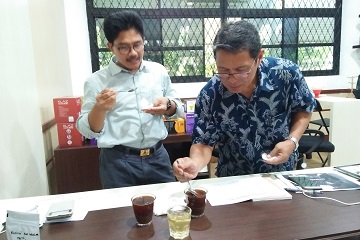Learn Coffee Cupping à la IPB’s Faculty of Agriculture Lecturers

Nowadays, coffee has becoming a trend especially in the Indonesian young generation, from coffee businesses, coffee enthusiast until barista.
IPB’s Faculty of Agriculture Lecturers also embracing this new trend. Therefore, the Dean of Faculty of Agriculture encouraged the lecturers to join a coffee cupping. There were ten lecturers from Faculty of Agriculture joining the coffee cupping training. Coffee cupping is a process of observing the taste of the coffee before the coffee is given to the coffee enthusiast. “We learned how to make the right coffee so our way to consume it is also right and it could actually help us maintain our health,” said Dr. Ir. Suwardi, M.Agr the Dean of Faculty of Agriculture.
Dr. Suwardi said that by learning how to make coffee we could increase the value of the coffee product itself. Dr. Suwardi hoped that by conducting this training they could introduce Indonesian coffees to guests that visit Faculty of Agriculture. “When there are foreign guests, we could serve Indonesian coffee so that this coffee product could be acknowledged by the larger communities.” added Suwardi.
This training led by a barista and owner of a coffee shop, Firdaus Alam, who is also one of Faculty of Agriculture’s alumnus. This coffee cupping held to recognize the taste of the coffee before it is served. Not everyone could do this, so this coffee cupping is demonstrated first by the expert.
The appraisal on this coffee cupping has four attributes which are fragrance, aroma, sweetness, and body. The criterion of good coffee is that it has strong character in every attribute even though it is being mixed by other elements.
Cupping process can be easy. Before the cupping process tarter, the coffee sample should be roaster and grinded first with certain size. In cupping process, first we have to recognize the smell of the coffee before it is brewed. After that, we added water to the grinded coffee with a comparison 1 to 16. Before being tested, let the coffee become a bit colder around 3-5 minutes. After being brewed, smell the aroma and compare it to the previous aroma before it is being brewed. Aroma produced by the coffee could be enzymatic (e.g. flowery, fruity, spicy), sugar browning (e.g. nuts, caramel, chocolate) or dry distillation (e.g. carbon, medicine).
The next step is to check the acidity of the coffee. In this step, the participants were asked to eliminate the coffee dregs from the cup, scooping the coffee, and sip the coffee. When the coffee reached the mouth’s ceiling and the edge under the tongue, participants can taste the acidity just like when they eat fruits or sipping wine with a slight of sweet taste. The final step is the participants were asked to acknowledge the taste by giving a description on coffee taste that were given.
“This cupping process needs space with stable temperature, closed, and avoid many people that are passing by. Because when it is conducted in an open space, the wind that blown could affect the aroma of the coffee.” said Firdaus. (AVR)


